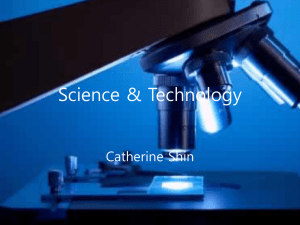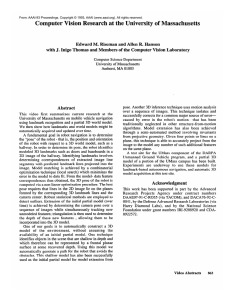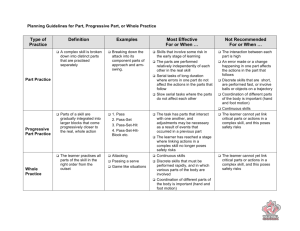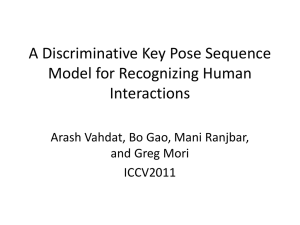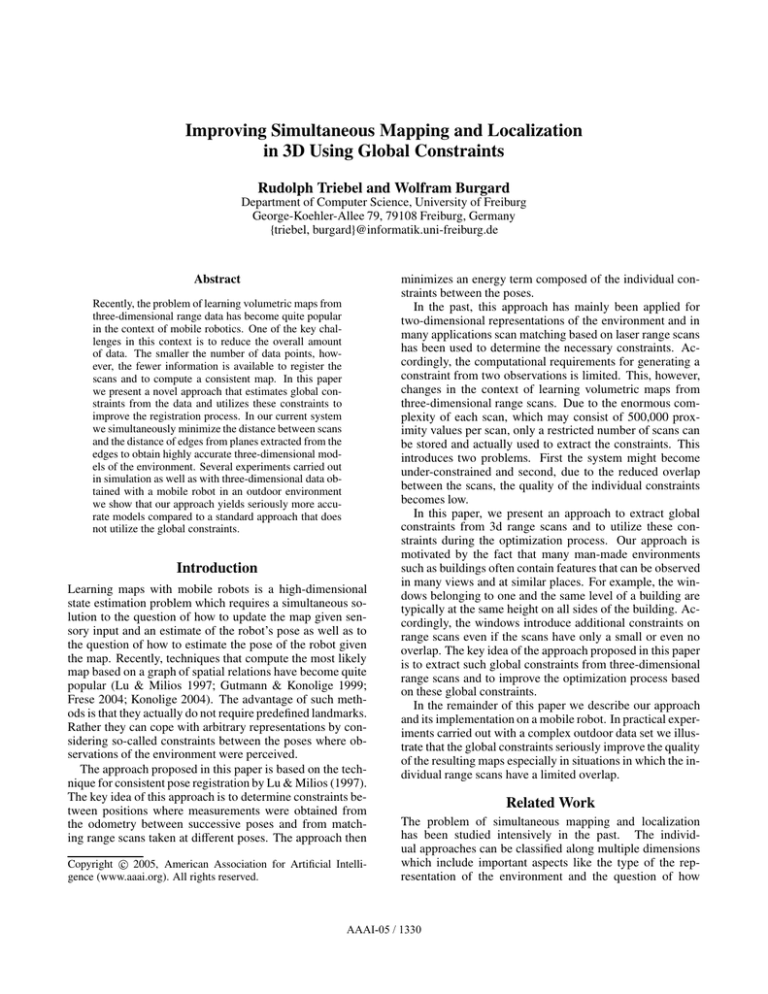
Improving Simultaneous Mapping and Localization
in 3D Using Global Constraints
Rudolph Triebel and Wolfram Burgard
Department of Computer Science, University of Freiburg
George-Koehler-Allee 79, 79108 Freiburg, Germany
{triebel, burgard}@informatik.uni-freiburg.de
Abstract
Recently, the problem of learning volumetric maps from
three-dimensional range data has become quite popular
in the context of mobile robotics. One of the key challenges in this context is to reduce the overall amount
of data. The smaller the number of data points, however, the fewer information is available to register the
scans and to compute a consistent map. In this paper
we present a novel approach that estimates global constraints from the data and utilizes these constraints to
improve the registration process. In our current system
we simultaneously minimize the distance between scans
and the distance of edges from planes extracted from the
edges to obtain highly accurate three-dimensional models of the environment. Several experiments carried out
in simulation as well as with three-dimensional data obtained with a mobile robot in an outdoor environment
we show that our approach yields seriously more accurate models compared to a standard approach that does
not utilize the global constraints.
Introduction
Learning maps with mobile robots is a high-dimensional
state estimation problem which requires a simultaneous solution to the question of how to update the map given sensory input and an estimate of the robot’s pose as well as to
the question of how to estimate the pose of the robot given
the map. Recently, techniques that compute the most likely
map based on a graph of spatial relations have become quite
popular (Lu & Milios 1997; Gutmann & Konolige 1999;
Frese 2004; Konolige 2004). The advantage of such methods is that they actually do not require predefined landmarks.
Rather they can cope with arbitrary representations by considering so-called constraints between the poses where observations of the environment were perceived.
The approach proposed in this paper is based on the technique for consistent pose registration by Lu & Milios (1997).
The key idea of this approach is to determine constraints between positions where measurements were obtained from
the odometry between successive poses and from matching range scans taken at different poses. The approach then
c 2005, American Association for Artificial IntelliCopyright gence (www.aaai.org). All rights reserved.
minimizes an energy term composed of the individual constraints between the poses.
In the past, this approach has mainly been applied for
two-dimensional representations of the environment and in
many applications scan matching based on laser range scans
has been used to determine the necessary constraints. Accordingly, the computational requirements for generating a
constraint from two observations is limited. This, however,
changes in the context of learning volumetric maps from
three-dimensional range scans. Due to the enormous complexity of each scan, which may consist of 500,000 proximity values per scan, only a restricted number of scans can
be stored and actually used to extract the constraints. This
introduces two problems. First the system might become
under-constrained and second, due to the reduced overlap
between the scans, the quality of the individual constraints
becomes low.
In this paper, we present an approach to extract global
constraints from 3d range scans and to utilize these constraints during the optimization process. Our approach is
motivated by the fact that many man-made environments
such as buildings often contain features that can be observed
in many views and at similar places. For example, the windows belonging to one and the same level of a building are
typically at the same height on all sides of the building. Accordingly, the windows introduce additional constraints on
range scans even if the scans have only a small or even no
overlap. The key idea of the approach proposed in this paper
is to extract such global constraints from three-dimensional
range scans and to improve the optimization process based
on these global constraints.
In the remainder of this paper we describe our approach
and its implementation on a mobile robot. In practical experiments carried out with a complex outdoor data set we illustrate that the global constraints seriously improve the quality
of the resulting maps especially in situations in which the individual range scans have a limited overlap.
Related Work
The problem of simultaneous mapping and localization
has been studied intensively in the past. The individual approaches can be classified along multiple dimensions
which include important aspects like the type of the representation of the environment and the question of how
AAAI-05 / 1330
the posterior about the robot’s pose and the map is represented. Extended Kalman Filter methods belong to the
most popular approaches and different Variants of this technique have been proposed (Moutarlier & Chatila 1989;
Leonard & Feder 1999; Guivant, Nebot, & Baiker 2000;
Dissanayake et al. 2001; Thrun et al. 2004). The key idea
of these techniques is to simultaneously estimate the poses
of landmarks using an Extended Kalman Filter or a variant
of the Extended Information Filter. As mentioned above,
an alternative approach is to compute the most likely map
based on a graph of spatial relations (Lu & Milios 1997;
Gutmann & Konolige 1999; Frese 2004; Konolige 2004).
The advantage of such methods is that they do not require predefined landmarks. Rather they can cope with arbitrary representations by considering so-called constraints
between the poses where observations of the environment
were perceived. However, most of these approaches rely on
the assumption that the environment can be represented by a
two-dimensional structure.
Recently, several authors investigated the problem of constructing 3d-models of buildings. For example, Stamos &
Leordeanu (2003) construct 3d-models by combining multiple views obtained with a 3d range scanner. Früh & Zakhor (2004) present a technique to learn accurate models
of large-scale outdoor environments by combining laser, vision, and aerial images. Thrun, Burgard, & Fox (2000)
use two 2d range scanners. The first is oriented horizontally whereas the second points toward the ceiling. By
registering the horizontal scans the system generates accurate three-dimensional models. In a more recent work by
Thrun et al. (2003) several range scanners were used to
learn models of underground mines. Nüchter, Surmann,
& Hertzberg (2003) developed a robot that is able to autonomously explore non-planar environments and to simultaneously acquire the three-dimensional model. Compared
to these approaches, which directly compare range scans to
estimate the pose of the vehicles, the algorithm proposed
in this paper extracts global constraints from the range scans
and utilizes these constraints in an optimization process similar to that of Lu & Milios (1997). As a result, our algorithm
can cope with fewer scans and even with a smaller overlap
between the individual scans.
constraint between the connected nodes. Note that this is an
extension of the link definition given by Lu & Milios (1997)
who only consider links between pairs of nodes. In the following, we will deal with two different kinds of network
links, namely
• links that connect exactly two consecutive robot poses
(so-called local links) and
• links that connect several, not necessarily consecutive,
robot poses (denoted as global links).
3D vs. 2D Registration
Lu & Milios (1997) represent a local constraint between
poses pi and p j as the difference Di j in position and orientation. Let us assume that Ri j is the rotation matrix corresponding to the difference (ϕ j − ϕi , ϑ j − ϑi , ψ j − ψi ) in the
Euler angles of pi and p j . The term Di j is considered a random variable with mean D̄i j and covariance C i j . Assuming
that an estimate of D̄i j is given by local scan matching in
terms of a rotation R̄i j and a translation t̄i j , we can express
each scan point zih from view Vi in the local coordinate system of pose p j as
i
z̄ih = R−1
j (R̄i j (Ri zh + xi ) + t̄i j − x j ),
(1)
where R j is the rotation defined by (ϕ j , ϑ j , ψ j ) and Ri the one
defined by (ϕi , ϑi , ψi ).
In order to understand the additional problems introduced
by moving from 2d to 3d, let us consider the pose differences
Di j in the situation in which xi = 0 and x j = 0. If the scan
matching is perfect, we obtain t̄i j = 0. Under the assumption that the common points in both scans can be matched
perfectly, this results in
j
i
zh = R−1
j R̄i j Ri zh .
(2)
Here we can see a major difference between the 2D case
and the 3D case. For rotations in 2D it is guaranteed that
R̄i j = Ri j . This can be seen by setting two of the Euler angles to 0. In 3D however, this is not true in general. In practical experiments we found out that in 3d the approximation
of Ri j by R̄i j obtained from scan matching introduces a linearization error that often prevents the optimization process
from converging.
Definition of Local Constraints
Network-based Pose Optimization
Suppose we are given a set of N partial views V1 , . . . , VN of
a scene in 3D. A view Vn is defined by a set of s(n) points in
3D, where s(n) is defined as the size of view Vn . We will denote these points as zn1 , . . . , zns(n) . Each view Vn is taken from
a position xn ∈ R3 and an orientation (ϕn , ϑn , ψn ). The tuple (xn , ϕn , ϑn , ψn ) is denoted as the robot pose pn . The goal
now is to find a set of poses that minimize an appropriate
error function based on the observations Vi , . . . , VN .
Following the approach described by Lu & Milios (1997),
we formulate the pose estimation problem as a system of error equations that are to be minimized. We represent the set
of robot poses as a constraint network, where each node corresponds to a robot pose. A link l in the network is defined
by a set of nodes that are connected by l. It represents a
To cope with this problem, we consider a quadratic error
function and in this way avoid linearization errors. More
specifically, we compute the sum of squared errors between
corresponding points from both views Vi and V j . This means
that the error defined between poses pi and p j can be expressed as
l(pi , p j ) :=
C
X
kRi zic1 (ν) + xi − (R j zcj2 (ν) + x j )k2 (3)
ν=1
where (c1 (1), c2(1)), . . . , (c1 (C), c2 (C)) is the set of C correspondences between points from the views Vi and V j .
Since this error function is non-linear in the pose parameters pi and p j we cannot use the closed-form solution generally used in the context of two dimensions.
AAAI-05 / 1331
Definition of Global Constraints
In general, a global constraint between different robot poses
can be defined in many possible ways. For example, if a set
of 3D landmarks λ1 , . . . , λG with known poses is given, then
each of these landmarks constitutes a global constraint on all
robot poses from which a partial view onto the landmark was
taken. The evaluation function γ j that corresponds to the
global constraint g j is then defined by the squared Euclidean
distance between the view Vi and the landmark λ j .
In this paper, we will not assume the existence of known
landmarks. We rather define the global constraints based on
the object(s) seen from the different views. This stems from
the observation that many real world objects, such as buildings are highly self-similar. For example, if a building is
seen from two sides, it is very likely that specific features
that are extracted from both views (e.g., windows, the edge
between walls and the roof etc.) are on the same absolute
height in both views. In general, many different types of
features are possible, where high-level features such as windows, doors etc. constrain the algorithm to be applicable for
specific objects like buildings. We therefore rely on lowlevel features, in particular 3D edges.
Before we discuss how to extract edges from range scans,
we will first describe how we actually use the edges to generate global constraints. Assume we are given a set of edge
features Ei = {ei1 , . . . , eiM } for each view Vi . We define a
global constraint as a plane P that has a sufficient support by
edges detected in different views. Here the support supp(P)
of a plane P is defined by all edges e that lie entirely inside a
given corridor around the P. Given the support we calculate
the error imposed by a global constraint g between the poses
pi1 , . . . , pik as
g(pi1 , . . . , piK ) :=
K
X
X
d(Rik e + tik , P) (4)
k=1 e∈Eik ∩ supp(P)
Here, d defines the squared distance of the rotated and translated edge e to the plane P. In our implementation, this
equals the sum of squared Euclidean distances between the
transformed vertices of e and P.
Pose estimation
As stated above, we formulate the pose estimation as a minimization problem for a given set of error equations. Suppose
the network consists of L local and G global constraints. The
aim now is to find a set of poses p1 , . . . , pN that minimizes
the overall error function f :
f (p1 , . . . , pN ) :=
L
X
li (pν1 (i) , pν2 (i) ) · α +
G
X
gi (pν1 (i) , . . . , pνK(i)(i) ) · (1 − α) (5)
i=1
i=1
Here, α is introduced as a factor that weighs between local
and global constraints. To solve this non-linear optimization
problem we f by using the Fletcher-Reeves gradient descent
algorithm.
It should be noted that the global minimum for the error function f is not unique. This is because both local and
global constraints are only defined with respect to the relative displacements between the robot poses and the global
minimum of f is invariant with respect to affine transforms
of the poses. In practice, this problem can be solved by fixing one of the robot poses at its initial value. Then the other
poses are optimized relative to this fixed pose.
Approximating Correspondences and Planes
When formulating the error functions in Eqns. (3) and (4) we
assumed some prior knowledge about the local and global
constraints. In the case of the local constraints, we assumed that the correct correspondences between points in
two different views are given. For the global constraints
we assumed that the optimal coordinates for the planes are
given. However, in practice both assumptions do not hold.
Therefore we approximate both the correspondences and the
planes for the global constraints.
Obtaining the Correspondences
For a given set of initial robot poses pi and p j we calculate
the correspondences of points between consecutive views V i
and V j by applying a variant of the Iterative Closest Point
scan matching algorithm (ICP) described in (Besl & McKay
1992). After convergence of the ICP, we obtain the correspondences directly from the last ICP iteration. In general,
ICP is not guaranteed to converge to a global optimum. In
fact, the convergence highly depends on the initial values for
the poses. This means that the poses that minimize Eqn. (3)
are in general not globally optimal. It is not even guaranteed
that they are a better approximation to the global optimum
than the initial poses are, because the ICP may diverge in
some cases.
Obtaining the Planes
Similar to the correspondences for the local constraints, we
approximate the planes for the global constraints from a set
of initial poses p1 , . . . , pN . From the resulting set of edge
features E1 , . . . , E N we compute a set of planes so that their
normal vectors are orthogonal to at least two edges. By doing this we obtain for example the surface planes of a building. These planes constrain all views that have edges close
the planes to be aligned to the planes.
Dependency between Constraints and Poses
Both the approximation of the correspondences and the
planes is dependent on the initial state of the robot poses.
This means that a good first estimate of the poses yields
a good approximation of the local and global constraints.
Conversely, a good approximation of the constraints reduces
the probability of running into local minima during the pose
optimization process. In other words, we have a circular dependency between constraints and robot poses. Therefore,
the idea is to estimate both constraints and poses iteratively.
Note that such an approach is applied in many other iterative approximation methods such as Expectation Maximization (EM), where a set of hidden random variables, that are
AAAI-05 / 1332
Edgels
d1
PSfrag replacements
d2
dn−1
dn
Figure 1: Detection of edgels. These are defined as scan
points in a vertical scan line that have a distance di from the
view point which is smaller than the difference of a neighbor’s distance and a given threshold τ, i.e.: di < di−1 − τ or
di < di+1 − τ
dependent on the parameters, is estimated and fed back to
the optimization of the parameters. In contrast to the maximum likelihood estimation process applied in an EM framework, our algorithm is not guaranteed to converge. However,
in our experiments we found that by introducing the global
constraints the iterative optimization gets more stable with
respect to convergence.
Feature Extraction
As described above, our algorithm relies on the extraction
of 3D edge features from each partial view Vi . These edge
features are then used to determine a set of planes representing the global constraints. In the following, we describe the
details of the feature extraction process.
Edges from Views
For a given view Vn , the edge features are extracted as follows:
1. We detect a set of edge points (edgels). These are defined
as scan points in a vertical scan line for which one vertical
neighbor point is far away from the view point compared
to the edgel itself (see Fig. 1).
2. Then we calculate the tangent vectors t j for each edgel e j .
Here, t j is defined by the first principle direction for a set
of edgels in the vicinity of e j .
3. Next, we cluster the edgels twice. The first clustering
is done with respect to the tangent directions. We use a
spherical histogram to find tangent vectors that point into
similar directions. The obtained clusters are then clustered wrt. the positions of the edgels in space. This is
done using a region growing technique.
4. Finally, we connect all edgels in one cluster to a polyline.
Fig. 2 shows an example of a set of edge features extracted
from a real 3d scan. In this figure, only polylines with a
minimum length of 3m are shown.
Planes from Edges
Once the edge features have been extracted from the partial views, we search for planes that are orthogonal to at
Figure 2: Extracted edge features extracted from a single 3d
scan of a building.
least two edges, which may not be parallel and at the same
time close to each other, in the remainder denoted as equal.
Note that this problem is different from clustering edges into
planes, because one edge can lie in several planes. This
means that standard clustering methods – like EM-based
clustering (Liu et al. 2001) – cannot be applied.
In our current system we instead use a variant of the
RANSAC algorithm (Fischler & Bolles 1981). We start by
randomly sampling an edge pair (e1 , e2 ) from the set of all
pairs of non-equal edges. Here, an edge pair is sampled with
a probability proportional to the sum of the length of both
edges. This way we obtain with a higher likelihood planes
that have a high support. Next, we find the plane Pm that is
orthogonal to both edges of the pair. Here we have to consider two different cases, namely that e1 and e2 are parallel,
but far away from each, or that e1 and e2 are not parallel.
In the first case, an orthogonal vector to e1 and e2 is not
uniquely defined. Therefore, we define Pm in this case as
the plane that minimizes the squared distance to all edgels
from e1 and e2 . In the second case, the normal vector of Pm
is defined by the cross product of the main directions of e1
and e2 .
The next step includes the calculation of the support of
the resulting plane Pm . After this we apply a hill climbing
strategy to obtain more general planes by fitting a new plane
P0m into all edges from the support of plane Pm . This is done
by finding a normal vector v∗ so that
v∗ = arg min kAvk, kvk = 1
v
(6)
where A is a k × 3 matrix consisting of all tangent vectors
corresponding to the edges from the support of Pm .
The minimum in Eqn. (6) is determined by computing the
singular value decomposition (SVD) of A. The optimal normal vector v∗ is then obtained as the last column of the matrix V where A = UDV T , assuming the singular values in D
are sorted in descending order.
Experimental Results
To evaluate our algorithm we implemented it and tested it on
real data as well as in simulation runs. The goal of the experiments reported here is to illustrate that the incorporation
AAAI-05 / 1333
Table 1: Comparison of performance for different registration algorithms with respect to average angular deviation µ
(in radians) and positional deviation µ x (in meters)
Method
µ
µx
local constr.
0.0175 0.1595
global + local constr. 0.0071 0.1109
of global constraints increases the accuracy of the resulting
models.
Real World Experiment
In order to analyze the performance of our registration algorithm in practice, we tested it with a data set taken from a
real world scene. The data set consisted of 6 different threedimensional scans taken from a building that is about 70m
long, 20m wide and 11m high from the ground to the roof
edge.
Fig. 4 shows the result of the view registration using
global constraints. As can be seen, 5 different planes were
detected by our algorithm. These planes were used as global
constraints in the network of robot poses. The figure also
depicts close-up-views of several parts of the model. Shown
are the results obtained with our approach and with local
constraints only. As can be seen from the figure, the edges
detected in the partial views have been aligned more accurately to the planes using our approach. Especially at the
roof plane we can see that the views are all at the same level.
To quantify the improvement we measured the variance σα
of the absolute angular deviation of the edges from the corresponding plane tangent. For the global-constraint based
registration we obtained σα = 0.75. In contrast, the local
constraints only produce a value of σα = 2.56.
Quantitative Results
corporation of global constraints improves the registration
process. Especially the angular deviation is smaller when
using global constraints. This is because the global planar
constraints correct smaller errors that arise from the local
scan matcher. These errors are mainly encountered in the
rotations.
In the case of a high noise variance, the algorithm that
uses only local constraints always diverged. This is because
the local scan matching could not find enough correspondences and therefore diverged. However, in some of these
cases convergence could be achieved by adding the global
constraints.
In a further experiment we demonstrate the performance
of our approach in situations where few overlap is given between the individual partial views. Again, we used the scene
shown in fig. 3. We ran the registration process using different numbers of partial views, ranging from 6 down to
2, where the overlap decreased with the number of views.
Fig. 5 plots the rotational deviations from the ground truth.
As can be seen, our algorithm performs significantly better
(α = 0.05) in situations with fewer overlap between the individual views.
0.1
deviation from ground truth
Figure 3: Simulated scene used to verify the performance of
the algorithm. left: 3D view of the scene; right: 4 generated
partial views shown in an explosion view drawing.
PSfrag replacements
To more systematically evaluate the quality of the models
obtained with our algorithm and in comparison with other
approaches we performed a series of experiments using the
simulated scene shown in Figure 3. The object is 3m wide,
5m long and 3m high. In the particular experiment reported
here we generated 4 different scans. These scans are shown
in Figure 3 in an exploded view drawing. For the initial
poses we added Gaussian noise to the poses known from the
ground truth. The noise added to the angles had a variance
that was different from the noise variance added to the positions. We ran two different kinds of experiments where
the noise variances were (0.0005|0.05) and (0.0008|0.08) respectively. For both noise levels we started the optimization
with 10 different initial sets of poses. We evaluated both the
registration method using only local constraints and the one
using local and global constraints.
The results for the low variance case are summarized in
Table 1. Shown are the average deviations in angle µ and
position µ x from the ground truth. As can be seen, the in-
Using local constraints
Using global and local constraints
0.08
0.06
0.04
0.02
0
6
5
4
3
number of scans
2
Figure 5: Statistical analysis of the registration process with
respect to the angular rotation from the ground truth
Conclusions
This paper describes an approach to learn accurate volumetric models from three-dimensional laser range scans. The
key idea of our approach is to extract global constraints from
the individual scans and to utilize these constraints in during
the alignment process. Our algorithm has been implemented
and tested on real data and in simulation. Experimental results demonstrate that our approach yields more accurate
models especially in situations in which only a few scans
with little overlap are given.
AAAI-05 / 1334
Local and Global Constraints
Local Constraints
PSfrag replacements
Figure 4: Registered data set from an outdoor scene. Shown are the range data and the edges used to extract the planes as global
structures.
Acknowledgments
This work has partly been supported by the German Research Foundation under contract number SFB/TR8.
References
Besl, P., and McKay, N. 1992. A method for registration of
3D shapes. Transactions on Pattern Analysis and Machine
Intelligence 14(2):239–256.
Dissanayake, G.; Newman, P.; Clark, S.; Durrant-Whyte,
H.; and M., C. 2001. A solution to the simultaneous localisation and map building (slam) problem. IEEE Transactions on Robotics and Automation.
Fischler, M. A., and Bolles, R. C. 1981. Random sample
consensus: A paradigm for model fitting with applications
to image analysis and automated cartography. Comm. Assoc. Comp. Mach. 24(6):381–396.
Frese, U. 2004. An O(log n) Algorithm for Simulateneous
Localization and Mapping of Mobile Robots in Indoor Environments. Ph.D. Dissertation, University of ErlangenNürnberg.
Früh, C., and Zakhor, A. 2004. An automated method for
large-scale, ground-based city model acquisition. International Journal of Computer Vision 60:5–24.
Guivant, J.; Nebot, E.; and Baiker, S. 2000. Autonomous navigation and map building using laser range
sensors in outdoor applications. Journal of Robotics Systems 17(10):565–583.
Gutmann, J., and Konolige, K. 1999. Incremental mapping
of large cyclic environments. In International Symposium
on Computational Intelligence in Robotics and Automation
(CIRA).
Konolige, K. 2004. Large-scale map-making. In Proc. of
the National Conference on Artificial Intelligence (AAAI).
Leonard, J., and Feder, H. 1999. A computationally efficient method for large-scale concurrent mapping and local-
ization. In Proceedings of the Ninth International Symposium on Robotics Research.
Liu, Y.; Emery, R.; Chakrabarti, D.; Burgard, W.; and
Thrun, S. 2001. Using EM to learn 3D models with mobile
robots. In Proceedings of the International Conference on
Machine Learning (ICML).
Lu, F., and Milios, E. 1997. Globally consistent range scan
alignment for environment mapping. Autonomous Robots
4:333–349.
Moutarlier, P., and Chatila, R. 1989. An experimental
system for incremental environment modeling by an autonomous mobile robot. In Proc. of the International Symposium on Experimental Robotics.
Nüchter, A.; Surmann, H.; and Hertzberg, J. 2003. Planning robot motion for 3d digitalization of indoor environments. In Proc. of the 11th International Conference on
Advanced Robotics (ICAR).
Stamos, I., and Leordeanu, M. 2003. Automated featurebased range registration of urban scenes of large scale. In
Proc. of the IEEE Computer Society Conference on Computer Vision and Pattern Recognition (CVPR).
Thrun, S.; Hähnel, D.; Ferguson, D.; Montemerlo, M.;
Triebel, R.; Burgard, W.; Baker, C.; Omohundro, Z.;
Thayer, S.; and Whittaker, W. 2003. A system for volumetric robotic mapping of abandoned mines. In Proc. of
the IEEE International Conference on Robotics & Automation (ICRA).
Thrun, S.; Liu, Y.; Koller, D.; Ng, A.; Ghahramani, Z.; and
Durant-Whyte, H. 2004. Simultaneous localization and
mapping with sparse extended information filters. International Journal of Robotics Research 23(7-8):693–704.
Thrun, S.; Burgard, W.; and Fox, D. 2000. A real-time
algorithm for mobile robot mapping with applications to
multi-robot and 3D mapping. In Proc. of the IEEE International Conference on Robotics & Automation (ICRA).
AAAI-05 / 1335


